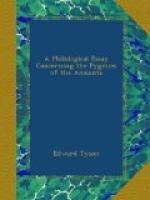Tyson (p. 29) quotes the following passage from Photius:—“That Nonnosus sailing from Pharsa, when he came to the farthermost of the islands, a thing very strange to be heard of happened to him; for he lighted on some (animals) in shape and appearance like men, but little of stature, and of a black colour, and thick covered with hair all over their bodies. The women, who were of the same stature, followed the men. They were all naked, only the elder of them, both men and women, covered their privy parts with a small skin. They seemed not at all fierce or wild; they had a human voice, but their dialect was altogether unknown to everybody that lived about them, much more to those that were with Nonnosus. They lived upon sea-oysters and fish that were cast out of the sea upon the island. They had no courage for seeing our men; they were frighted, as we are at the sight of the greatest wild beast.” It is not easy to identify this race with any existing tribe of Pigmies, but the hairiness of their bodies, and above all their method of clothing themselves, leave no doubt that in this account we have a genuine story of some group of small-statured blacks.
From the foregoing account it will be seen that it is possible with more or less accuracy and certainty to identify most of those races which, described by the older writers, had been rejected by their successors. Time has brought their revenge to Aristotle and Pliny by showing that they were right, where Tyson, and even Buffon, were wrong.
III.
The little people of story and legend have a much wider area of distribution than those of real life, and it is the object of this section to give some idea of their localities and dwellings. Imperfect as such an account must necessarily be, it will yet suffice I trust in some measure to show that, like the England of Arthurian times, all the world is “fulfilled of faery.”
In dealing with this part of the subject, it would be possible, following the example of Keightley, to treat the little folk of each country separately. But a better idea of their nature, and certainly one which for my purpose will be more satisfactory, can, I think, be obtained by classifying them according to the nature of their habitations, and mentioning incidentally such other points concerning them as it may seem advisable to bring out.




